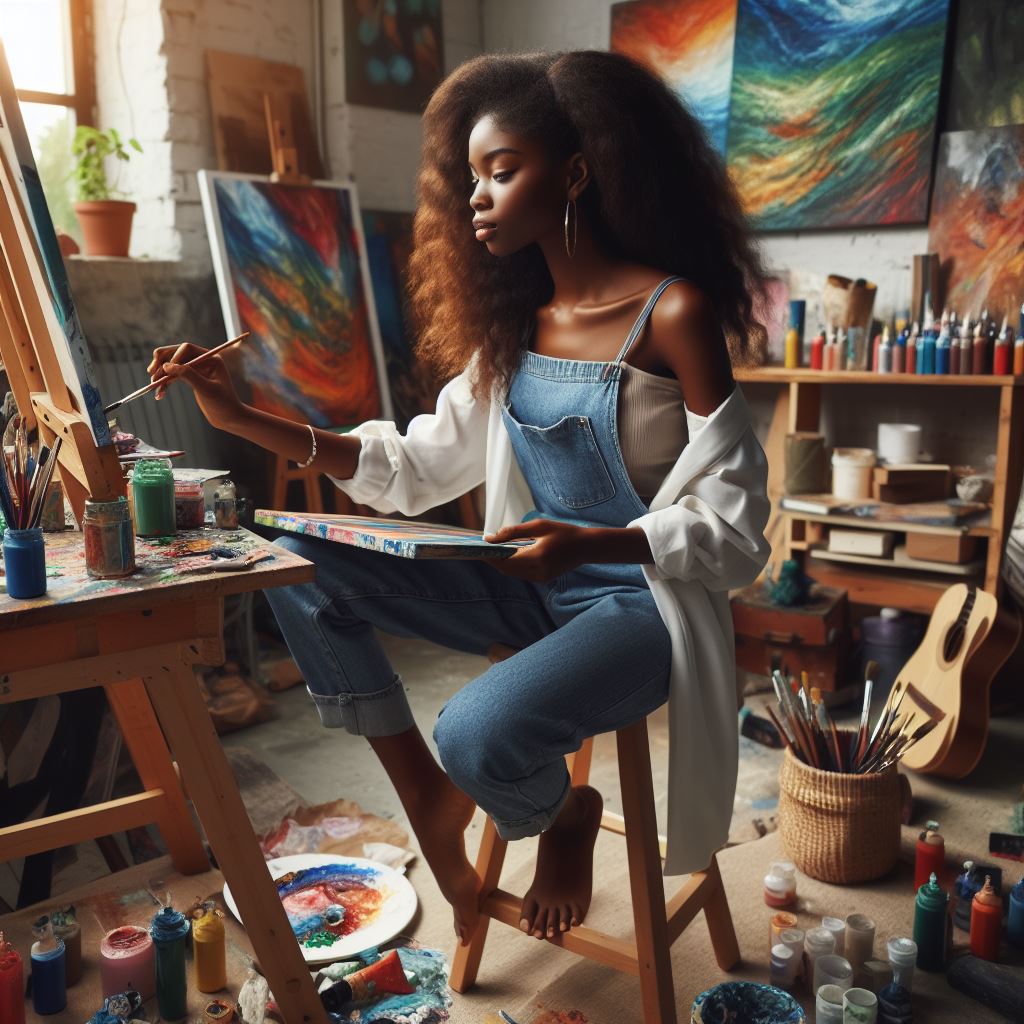Introduction
Nigerian art is a tapestry woven with threads of history, culture, and creativity, spanning centuries of artistic expression.
From ancient artifacts to contemporary masterpieces, Nigerian art reflects the country’s rich cultural heritage and diverse artistic traditions.
Key characteristics of Nigerian art include its vibrant colors, intricate patterns, and dynamic compositions.
Artists draw inspiration from a variety of sources, including mythology, spirituality, and everyday life, infusing their work with layers of meaning and symbolism.
Art plays a central role in Nigerian culture, serving as a means of communication, identity, and social cohesion.
It serves as a vehicle for storytelling, documenting the experiences and aspirations of the Nigerian people.
Moreover, art serves as a form of cultural preservation, transmitting knowledge and traditions from one generation to the next.
In essence, Nigerian art is a reflection of the country’s vibrant cultural tapestry, embodying the creativity, resilience, and diversity of its people.
Definition and Significance of Public Installations
Explanation of Public Installations
Public installations are expansive artworks strategically positioned in communal areas, accessible to all community members.
These installations come in diverse forms, ranging from monumental sculptures to captivating murals, interactive exhibits, and immersive multimedia displays.
Importance of Public Installations in Showcasing Art
Public installations serve as dynamic platforms for displaying art outside the confines of traditional gallery spaces.
By placing artworks in public settings, they democratize access to art, inviting everyone, regardless of background or socioeconomic status, to engage with creative expression.
These installations transform urban landscapes into open-air galleries, infusing public spaces with beauty, creativity, and cultural significance.
They serve as focal points for community interaction, drawing people together and fostering a sense of shared ownership and pride in local art.
Role of Public Installations in Promoting Cultural Awareness
Public installations are potent vehicles for promoting cultural awareness and appreciation.
They showcase the rich tapestry of Nigerian heritage, celebrating indigenous traditions, folklore, and historical narratives.
By incorporating local symbols, motifs, and themes into their designs, public installations resonate deeply with the community, reinforcing cultural identity and fostering a sense of belonging.
They serve as visual reminders of Nigeria’s diverse cultural landscape, encouraging dialogue and understanding among people of different backgrounds.
Moreover, public installations have the power to spark conversations about pressing social issues, such as environmental conservation, gender equality, and social justice.
Through thought-provoking artworks, artists can raise awareness about important topics, inspiring collective action and positive change within society.
In essence, public installations play multifaceted roles in Nigerian society, acting as catalysts for artistic expression, community engagement, and cultural enrichment.
By bringing art out of the gallery and into public spaces, they transform the urban environment into a vibrant canvas for creative exploration and collective celebration of Nigerian culture.
Read: Developing Critical Thinking in Language Arts
Examples of Public Installations in Nigeria
In recent years, Nigeria has seen a surge in public installations that showcase the country’s rich artistic heritage.
These installations not only beautify public spaces but also serve as a platform for artists to express themselves and engage with the community.
Overview of Popular Public Installations in Nigeria
- The National Arts Theatre in Lagos: This iconic structure is not only a performance venue but also features various sculptures and murals that represent Nigeria’s diverse culture.
- Fela Kuti Statue in Lagos: The larger-than-life statue of the legendary musician serves as a tribute to his contributions to Nigerian music and activism.
- Freedom Park in Lagos: This historical site now serves as a cultural center with various installations that commemorate Nigeria’s struggle for independence.
Detailed Description of Specific Installations
- The National Arts Theatre in Lagos: This monumental structure, designed by Architect Theo Lawson, stands as a symbol of artistic excellence in Nigeria. The Theatre’s exterior is adorned with intricate sculptures that depict scenes from Nigerian folklore and history.
- Fela Kuti Statue in Lagos: Located at Kalakuta Republic, the former residence of Fela Kuti, this statue captures the essence of the Afrobeat pioneer. The statue’s dynamic pose and expressive features pay homage to Fela’s electrifying stage presence.
- Freedom Park in Lagos: Built on the site of a colonial prison, Freedom Park now features art installations that highlight Nigeria’s journey to independence. From interactive exhibits to thought-provoking sculptures, the park offers visitors a glimpse into Nigeria’s past struggles and triumphs.
Significance of Each Installation in Nigerian Art Scene
- The National Arts Theatre: As a hub for performing arts and visual culture, the National Arts Theatre plays a crucial role in promoting Nigerian creativity. Its sculptures and murals serve as a testament to the country’s vibrant arts scene.
- Fela Kuti Statue: The statue of Fela Kuti immortalizes the legacy of a music icon who challenged social norms through his art. It embodies the spirit of rebellion and resilience that continues to inspire Nigerian artists today.
- Freedom Park: By repurposing a historical site for artistic expression, Freedom Park showcases the power of art in preserving collective memory. Its installations spark dialogue and reflection on Nigeria’s complex history, fostering a sense of unity among diverse communities.
Basically, public installations in Nigeria serve as more than just decorative elements in urban environments.
They are powerful tools for storytelling, cultural preservation, and community engagement.
As Nigeria continues to embrace its rich artistic heritage, these installations will undoubtedly play a significant role in shaping the country’s artistic landscape for generations to come.
Read: Student Experiences: Life in Communication Arts
Impact of Public Installations on Society
Influence of Public Installations on Community Engagement
Public installations foster community engagement by providing shared spaces for interaction and dialogue among residents.
These installations serve as focal points for community gatherings, cultural events, and public celebrations, creating opportunities for connection and collaboration.
Public installations also encourage community participation in the arts, empowering residents to contribute to the cultural fabric of their neighborhoods.
Role of Public Installations in Urban Development
Public installations play a vital role in urban development by revitalizing public spaces and enhancing the aesthetic appeal of urban environments.
They transform neglected areas into vibrant hubs of activity, attracting visitors, stimulating economic growth, and revitalizing local communities.
Moreover, public installations contribute to placemaking efforts, creating distinctive landmarks that define the identity and character of a city.
Contribution of Public Installations to Cultural Preservation
Public installations serve as tangible expressions of cultural heritage, preserving local traditions, stories, and symbols for future generations.
They celebrate the cultural diversity of Nigerian society, honoring indigenous knowledge, customs, and rituals through visual art.
Public installations also provide a platform for intergenerational exchange, facilitating the transmission of cultural values and traditions from elders to youth.
Essentially, public installations play a significant role in community engagement, urban development, and cultural preservation in Nigeria.
Through their presence in public spaces, these installations inspire connection, foster creativity, and celebrate the rich cultural heritage of the Nigerian people.
Read: Communication Arts: Balancing Theory and Practice

Find Out More: Famous Nigerian Artists in Fine and Applied Art
Challenges Faced by Public Installations in Nigeria
Public installations play a significant role in showcasing Nigerian art and culture to both locals and tourists.
However, several challenges hinder the successful implementation and sustainability of these projects.
Lack of government support for public art projects
- The lack of government funding and support is a major obstacle faced by public installations in Nigeria.
- Without financial assistance and resources, artists struggle to bring their creative visions to life in public spaces.
- Government indifference to promoting art in public spaces limits the growth and development of Nigerian art culture.
Vandalism and theft of public installations
- Vandalism and theft are prevalent issues that threaten the existence of public art installations in Nigeria.
- Individuals with malicious intent damage or steal artworks, diminishing the beauty and cultural significance of public spaces.
- Lack of security measures and surveillance makes it easier for vandals to target and destroy public installations.
Accessibility issues for public installations in remote areas
- Public installations in remote areas face challenges in terms of accessibility and maintenance.
- Infrastructure limitations make it difficult for artists to transport and install artworks in distant locations.
- Lack of maintenance and regular upkeep of public installations in remote areas results in their deterioration over time.
Generally, addressing these challenges is crucial to the preservation and promotion of Nigerian art through public installations.
Government support, community engagement, and improved security measures are necessary steps towards overcoming these obstacles and fostering a thriving art culture in Nigeria.
Read: How to Apply for Communication Arts Programs
You Might Also Like: Environmental Studies in African and Asian Context
Explore Further: Funding Your African and Asian Studies Education
Opportunities for Growth in Public Installations
Public installations in Nigeria present numerous opportunities for growth and development in the art scene.
This could be achieved through various strategies such as collaboration between artists and the government, increasing awareness and appreciation for public art, and integrating technology in installations for a wider reach.
Potential for Collaboration Between Artists and Government
- Government partnerships with artists can lead to more funding opportunities for public installations.
- Collaboration can also help in ensuring the longevity and maintenance of public art pieces.
- Working together can create a platform for artists to showcase their work to a wider audience.
- Government support can enhance the visibility and accessibility of public art to the community.
- Partnerships can also help in promoting local talents and cultural heritage through public installations.
Increasing Awareness and Appreciation for Public Art
- Organizing events and workshops can educate the public on the importance of public art installations.
- Creating interactive experiences can engage audiences and promote a deeper understanding of the artwork.
- Engaging with local communities can build a sense of pride and ownership in public art projects.
- Collaborating with schools and universities can foster a new generation of art enthusiasts and creators.
- Utilizing social media platforms can help in reaching a wider audience and generating interest in public art.
Integration of Technology in Public Installations for Wider Reach
- Using augmented reality can enhance the viewer’s experience and provide additional information about the artwork.
- Implementing digital mapping technology can help in creating interactive public art installations.
- Utilizing social media and online platforms can enable artists to connect with a global audience.
- Integrating lighting and sound technologies can create a dynamic and immersive experience for viewers.
- Leveraging virtual reality can allow people to experience public art installations from anywhere in the world.
Therefore, exploring Nigerian art through public installations offers vast opportunities for growth and development.
By fostering collaborations, increasing awareness, and integrating technology, the public art scene in Nigeria can thrive and continue to inspire and engage audiences for generations to come.
Delve into the Subject: Role of Nollywood in Nigerian Arts
Discover More: Nigerian Language Studies: Universities and Programs
Learn More: Anthropology and Nigerian Family Structures
Uncover the Details: Student Experiences in African and Asian Studies
Conclusion
In summary, public installations serve as dynamic portals that transport audiences into the heart of Nigerian artistry.
These monumental showcases not only amplify the voices of Nigerian artists but also bridge cultural divides, inviting all to partake in the rich tapestry of Nigerian creativity.
As stewards of art appreciation, we are called to action to support and promote these public installations, ensuring their preservation and accessibility for future generations.
By advocating for their significance, we champion the spirit of cultural exchange and unity.
Let us embark on a journey of discovery and appreciation, delving deeper into the narratives woven into each installation.
Through exploration and engagement, we can forge meaningful connections with Nigerian art, enriching our understanding of its heritage and legacy.
Together, let us celebrate the vibrant hues and intricate patterns that adorn the canvas of Nigerian culture, ensuring that its beauty shines bright for all to behold.




